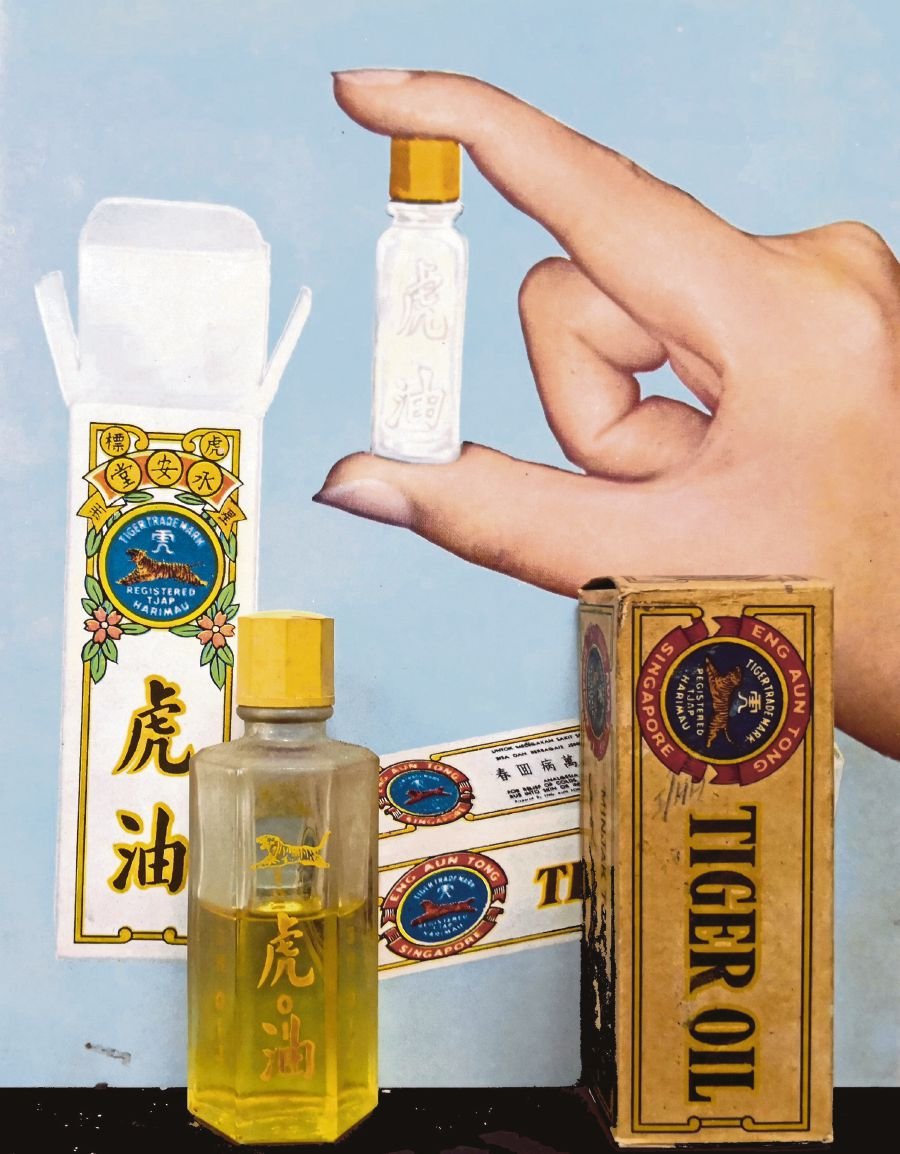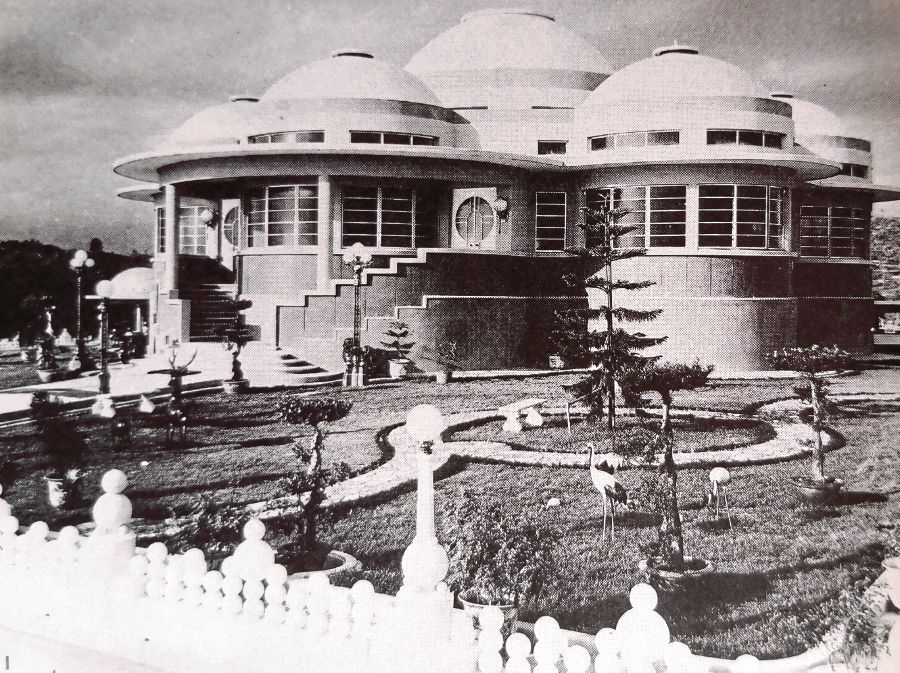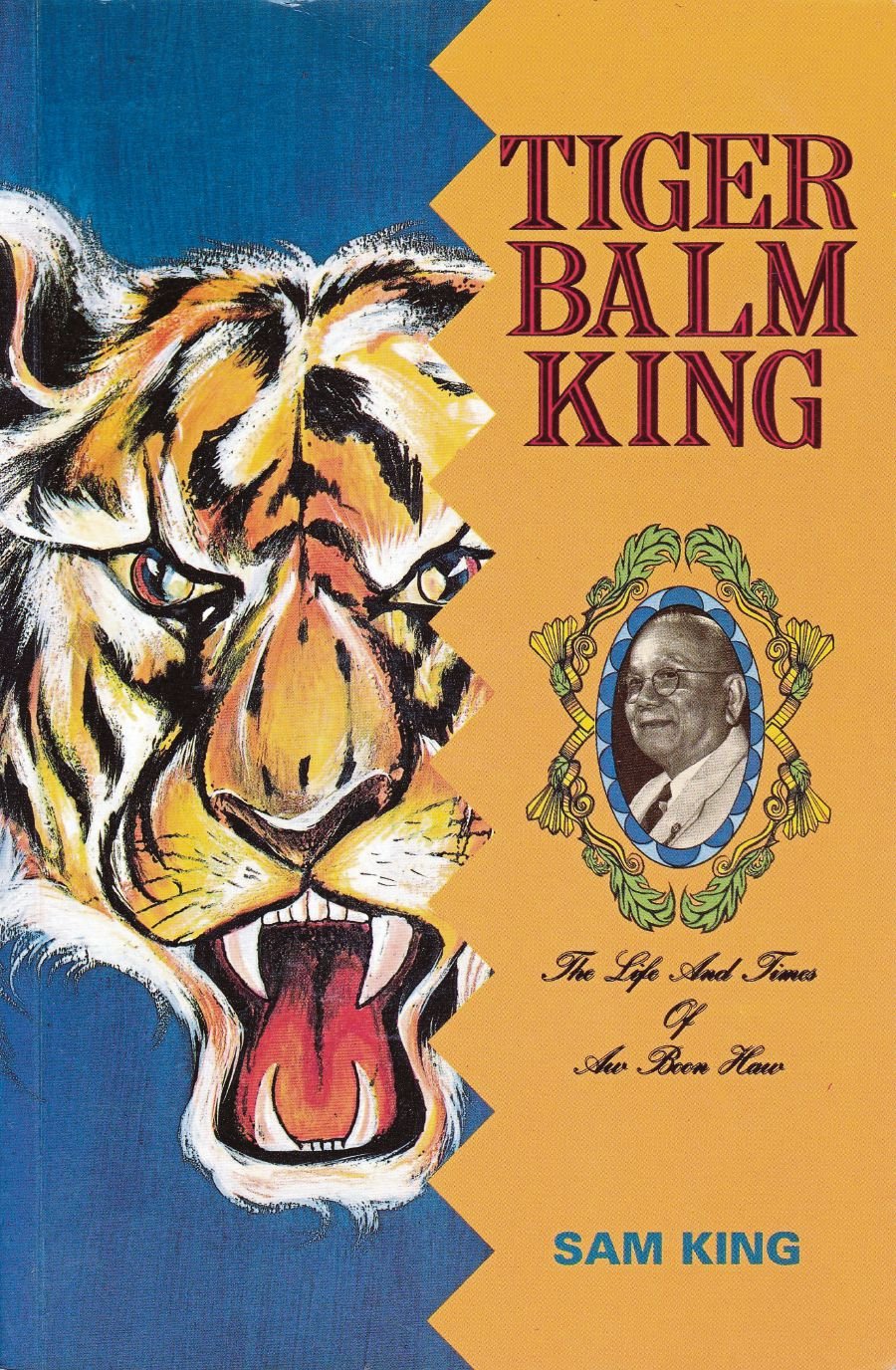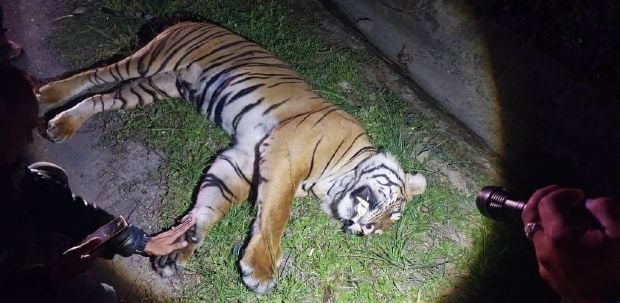A DISTINCT, strong sweet smell pervades the air as soon as I prise open the cover of a long forgotten medicine box. It came into my possession together with the contents of an entire house some three years back and had remained in an obscure corner until now.
Despite the presence of so many different types of medication that were common in Malayan households back in the 1960s, I could easily pinpoint the source of the aroma within seconds. Without a doubt, the smell is emanating from the box with “TIGER OIL” clearly emblazoned across its sides.
While removing the transparent hexagonal glass bottle from the box, I cannot help but feel amazed at the lasting qualities of its contents, which had expired more than half a century ago. The colour, intensity and aroma of the yellowish liquid looks and smells like it was bought just yesterday.
The product description on the box lists methanol crystal, camphor powder and various oils, like eucalyptus, wintergreen and clove, as active ingredients. It also states a long list of benefits.

Apart from being a mild antiseptic, the medicated oil manufactured by Eng Aun Tong professes to provide relief for colds, pain and respiratory ailments like cough when rubbed onto the skin or inhaled.
The last item on the remedy list strikes a chord. This popular product of yesteryears, if still around today, will surely prove useful in alleviating breathing complications of those affected by the dreaded haze scourge that affected our region last year.
Curious to learn more about the origins of the company, I head to my study to seek out related references. Within the hour, a sizeable pile of books and magazines containing articles and advertisements connected to Eng Aun Tong builds up on my table.
During the process, it dawns on me that the wealth of material available about the business entity, whose name literally translates to Hall of Everlasting Peace, is largely due to the fact that it is the company that owns the internationally renowned Tiger Balm brand.
HUMBLE BEGINNINGS
The amazing story of the Tiger Balm can be traced all the way back to Aw Leng Fan, a humble Hakka herbalist who lived with his family in Zhongchuan, an impoverished rural village in China’s Fujian province.
Although held in high esteem, Leng Fan found it difficult to make ends meet as people were either too poor or too frugal to pay for cures, and only saw him as a healer of last resort.
In 1863, Leng Fan received an invitation from a long-forgotten cousin to seek a better life by migrating to Burma (now Myanmar). Duty-bound to his fellow villagers and conscious of his advanced age, Leng Fan sent his son, Aw Chu Kin, in his stead and hoped for him to open a traditional medicine shop there.
At the coastal town of Amoy (now Xiamen), Chu Kin set sail on a junk ship destined for Nanyang, a general term used then for Southeast Asia. He survived the turbulent voyage and landed in Singapore before taking up temporary residence at a clan house in Telok Ayer Street.

Ten days later, he moved to Penang and, upon realising that the colony was urgently in need of a herbal practitioner, Chu Kin began providing services to the large population of Chinese immigrants in the British colony. Earning more in one week than his father did in 10 made him realise that Penang was indeed the land of opportunity.
Despite his success, the filial son felt obliged to his father’s wishes and sailed for Rangoon (now Yangon) in a fishing boat. With the financial support of his uncle, Chu Kin established Eng Aun Tong in 1870. His gentle demeanour and genuine concern for those who sought help ensured Chu Kin’s rapid rise as a trusted medical practitioner.
With the help of his uncle a few years later, Chu Kin was match made with Lee Kim Peck, a Teochew lass. Free of all domestic drudgery and pampered by a devoted wife, he turned his undivided attention towards the advancement of his business.
Among his patients were Chinese merchants, who were frugal in their spending habits. Although western medicine was within their means, they chose Chu Kin’s cheaper treatment.
BIRTH OF THE DRAGON, TIGER AND LEOPARD
When a son was born, the joyous father named him Boon Leong, which meant gentle dragon in the Hokkien dialect. The dragon son, however, did not live up to expectations as the business failed to progress after his birth.
In 1872, Kim Peck gave birth to another boy. No longer indulging in myths, Chu Kin studied the newborn’s horoscope and settled for Boon Haw, hoping that the name gentle tiger would give the boy ruthlessness, tempered with compassion.
Another son joined the family three years later and Chu Kin chose to remain earthbound and named the boy Boon Par, or gentle leopard.
As a child, Boon Haw behaved badly and was expelled from school after beating up his teacher. Left with no alternative, he was sent to his grandfather’s village in 1892 to further his knowledge in traditional herbal preparation.
Soon after, Boon Leong passed away. Chu Kin placed all hopes on his only remaining son and made sure he completed his English education. When Chu Kin died in 1908, Boon Par alone inherited Eng Aun Tong as his father had completely given up on Boon Haw.
The gentle leopard found the responsibility too much to shoulder alone. Instead of traditional herbs, his heart was with western medicine. He secured permission from his mother to run the apothecary together with his elder brother whom he planned to invite back from China.
When he stepped off the boat in Rangoon, Boon Haw looked worlds apart from the scrappy urchin that left for China years ago. The prodigal son had become a strapping young man who was a picture of matured confidence. Reunited, the brothers vowed to work as a team to bring fame and fortune to Eng Aun Tong.
My references are thrown into disarray at this juncture as I try to determine how the brothers came about the recipe for their hugely popular ointment.
Some claim that the formula originated from the court of the Chinese emperor, while another source claimed it involved a German pharmacist, who was a family friend.
A PRICELESS GIFT
Nevertheless, I am inclined to go with the version advocated by Sam King, whose 1992 biography of Boon Haw was accomplished with the cooperation of several Aw family descendants.

The contents suggest that Boon Par’s diligence at the western dispensary where he worked impressed an elderly pharmacist called U Thaw so much that he was presented with an ointment that could cure wide-ranging ailments. Sharing the gift with his brother after work, the siblings began plotting their path to success. Keen to give the product an auspicious name to mark the beginning of a profitable business venture, Boon Haw christened it Ban Kim Ewe.
Ban, meaning 10,000, was a magical figure in Chinese calculations, while kim, meaning gold, was the ultimate form of wealth and ewe, the Hokkien term for oil, completed the name that the brothers thought would give a lasting impression on their potential customers.
Thus, the Ten Thousand Golden Oil, the panacea for all ills, was born on that historic night.
As expected, the ointment became an overnight success. Keen to expand beyond their traditional Chinese customer base, the brothers renamed their product Tiger Balm in 1918. Through the use of attractive packaging and clever marketing strategies, the versatile balm and its sister products quickly became household standards in Malaya and the rest of Southeast Asia.
Among the schemes employed was the time-tested method of sample testing. Boon Haw had agents travel far and wide in carts to acquire customer feedback before using the valuable information to perfect the products.
With the ability to cure almost everything from headache to toothache to stomach ache and even flatulence, sales reached stratospheric levels quickly.
Demand increased on a daily basis and every dealer in the Orient made it their singular purpose to maintain a constant surplus stock of the products, which commanded a premium in more remote areas.
Barter trade swung into action whenever cash was short.
At that time, a bottle of Tiger Balm was fair exchange for a chicken or duck, while a packet of headache remedy was good for at least 10 eggs. Turnover was astronomical. For every bottle of western medicine bought, as many as 100 jars of Tiger Balm exchanged hands.
MOVE TO SINGAPORE
Just when everything was going like a well-oiled machine, a squad of policemen turned up at the brothers’ residence in Rangoon to charge them with illicit opium trafficking, together with the printing and circulation of counterfeit currency notes.
Although the case against them was never established, the incident was so humiliating that the brothers, who were one of the richest people in Rangoon at that time, decided to move their business to Singapore.
At the colony that bore his namesake, Boon Haw began building a new factory and headquarters worthy of the Eng Aun Tong name at the corner of Neil Road and Craig Road. In 1926, the imposing three-storey neo-classical landmark was open for business. Boon Par took up residence at Tanglin Road.
Apart from donating generously to charities and schools, maternity clinics, orphanages and homes for the aged, the brothers even went to the extent of launching their own newspapers with the primary aim of advertising their Tiger Balm products.
Sin Chew Jit Poh, their first paper, was published in Singapore on Jan 15, 1929. Sin Ping Jit Poh (now Guang Ming Daily) began in 1939. In Hong Kong and Thailand, they published Sing Tao Daily and Sin Siam Jit Poh respectively.
In 1932, Haw Par Brothers Pte Ltd was incorporated as a holding company for the business, assets and trademarks. As business expanded further to countries like India, the company started devising specific strategies to suit each individual market.
Throughout the expansion exercise, the company carefully protected its intellectual property rights by registering its Tiger Balm brand and leaping tiger emblem as trademarks in different countries all over the world.
SIBLING AFFECTION
As his wealth grew in tandem with the brand’s continued success, Boon Haw decided it was time to show appreciation to his brother for acquiring the ointment years ago in Rangoon that had given them such great wealth and fame.
In 1935, he acquired a large piece of land in Pasir Panjang Road to build Haw Par Villa, a sprawling mansion that would be a unique and fitting residence for Boon Par.
Ho Kwong Yew, a brilliant budding architect, was commissioned to design the house that would complement Boon Haw’s vision of a Tiger Balm Garden filled with thousands of statues and tableaux depicting scenes from Chinese myths and folklore.
The villa was completed in March 1937, which coincided with the eve of the Sino-Japanese war. Boon Par only lived there for a few years before fleeing with his family to Rangoon when the Japanese Imperial Army rolled into Singapore in 1942. Two years later, he passed away in the Burmese capital.
Instead of following in his brother’s footsteps, Boon Haw moved to Hong Kong and only returned to reestablish the business after the Japanese Imperial Army surrendered in 1945.
Diagnosed with a stomach ailment, Boon Haw flew to the United States to undergo a major operation on July 16, 1954. Although the surgery in Boston was a success, the 72-year-old tiger passed away from a heart attack on Sept 4 that same year during a stopover in Honolulu while on the flight back to Hong Kong. His vast empire was subsequently divided among six of his nine surviving children and four nephews.
While returning the references back to their rightful place, I take time to reflect upon the lives of the two brothers, whose genius and entrepreneurship gave them the opportunity create a product that has impacted the lives of generations.
Their success achieved through sheer determination and hard work while facing countless upheavals should serve as a useful lesson for young Malaysians aspiring to be successful.
Life is definitely filled with hurdles and it is up to us to remain steadfast to build something that is truly worthwhile for future generations to remember us by.





